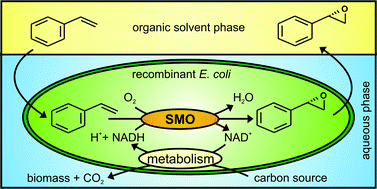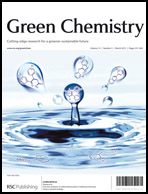Next to economic success, ecological considerations have become increasingly important for companies synthesizing various compounds ranging from bulk chemicals to pharmaceuticals. In this context, the economic and ecological feasibility of asymmetric biocatalytic styrene epoxidation has previously been investigated and compared to chemical alternatives. Although the biotechnological two-liquid phase approach was found to be highly interesting in economic terms, the ecological performance is restrained by the applied organic carrier solvent bis(2-ethylhexyl)phthalate, which is toxic to humans and produced from non-renewable resources. As an alternative carrier solvent, the biodiesel constituent ethyl oleate was tested. Furthermore, the switch from glucose to glycerol as a carbon and energy source was investigated, the latter being a cheap abundant resource, as it is a waste product of the biodiesel and soap industries. Both strategies slightly reduced the productivity and final product titer. An ecological and economic assessment on process level, however, revealed a superior environmental performance (by 13%) with ethyl oleate as the extractive solvent, at the expense of slightly reduced economics (by 9%), whereas glycerol use reduced the performance with respect to both aspects. Based on available data, the application of resting cells was evaluated, providing the opportunity of more efficient carbon utilization via decoupling of growth and biotransformation. Their stability is, however, yet to be improved to achieve competitiveness. In general, this study underlines the potential of ecological and economic assessments for systematic process intensification. Even if advantages of proposed changes seem obvious, their true suitability can only be judged by detailed economic and ecological analyses at the process level.


 Please wait while we load your content...
Please wait while we load your content...